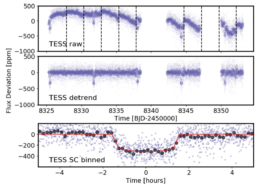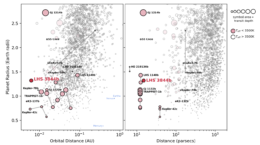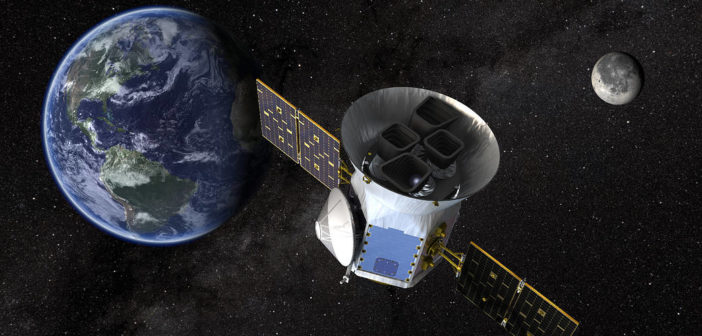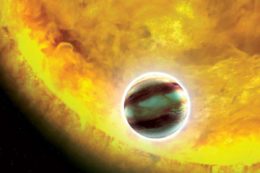What’s the news coming from NASA’s newest planet hunter, the Transiting Exoplanet Survey Satellite (TESS)? Launched in April 2018, TESS is expected to discover tens of thousands of exoplanets orbiting the nearest and brightest stars. Now that observations are underway, what exciting discoveries have been made? Read on for an update from just a few of the latest TESS studies published in AAS journals.
Around a Far Sun-like Star

Raw and corrected TESS light curves showing the five transits of π Men c. The bottom panel shows the folded light curve. [Huang et al. 2018]
At a distance of about 59 light-years, π Men is dimly visible to the naked eye near the south celestial pole. Over a decade ago, the Anglo-Australian Planet Search discovered a giant planet — π Men b — orbiting the star every 5.7 years. What TESS’s high-cadence observations revealed was a second, smaller planet orbiting the star every 6.27 days. By combining TESS photometry with precise radial-velocity measurements, Huang and collaborators determined the parameters of the planetary system, including the mass and radius of the newly discovered π Men c.
With a radius twice that of Earth and a mass nearly five times greater, π Men c isn’t an entirely “rocky” planet like the terrestrial planets in our solar system. Instead, it probably has a hydrogen-helium or water-methane envelope. We hope to learn more from future observations with the James Webb Space Telescope, Gaia, or even TESS itself!

Physical parameters of LHS 3844 b compared to other known exoplanets. Click to enlarge. [Vanderspek et al. 2019]
Another First for TESS
TESS won’t only find planets around Sun-like stars. Thanks to its redder observing bandpass (600–1000 nm, as opposed to Kepler’s 420–900 nm), TESS is especially sensitive to planets orbiting the small, reddish stars called M dwarfs. Because M dwarfs are so small and cool, planets in their habitable zones complete orbits in days rather than years, making them great observing targets.
A team led by Roland Vanderspek (MIT) analyzed data from the first month of TESS’s science operations, leading to the discovery of the first M-dwarf-orbiting planet detected by TESS. The planet, dubbed LHS 3844 b, has a radius 32% larger than Earth’s and orbits its small parent star at a distance of just 0.006 AU — swinging around LHS 3844 in just 11 hours. Although it’s unclear whether or not LHS 3844 b will have an atmosphere — it orbits so close to its host star that any atmosphere may have been torn away by stellar winds long ago — it’s definitely worth investigating the first (of many!) M-dwarf planets discovered by TESS.
Seeking Confirmation
As always with new detections, astronomers are rushing to confirm TESS’s discoveries with other telescopes and instruments. HD 202772A b is the first TESS hot Jupiter to have been confirmed by follow-up observations. In a recent study led by Songhu Wang (Yale University), the authors detail radial-velocity measurements made with the CHIRON, HARPS, and TRES spectrographs that confirm the planetary nature of HD 202772A b. This inflated gas giant is orbiting a quickly evolving star that’s one of the brightest and most massive stars known to host a hot Jupiter. As a result, HD 202772A b is one of the most strongly irradiated hot Jupiters currently known.Light Curves All Around
Want a chance to explore some TESS data on your own? Ryan Oelkers and Keivan Stassun (Vanderbilt University) have extracted and made available light curves from all the stars in TESS Sector 1, which is home to all three of the stars discussed above. Their website provides both raw and cleaned (systematic trends removed) light curves for each star, as well as information about each target (mass, luminosity class, magnitude, etc.).
As more TESS data rolls in, Oelkers and Stassun plan to update their website with the latest light curves for each observing sector. Happy planet hunting!
Citation
“TESS Discovery of a Transiting Super-Earth in the pi Mensae System,” Chelsea X. Huang et al. 2018 ApJL 868 L39. doi:10.3847/2041-8213/aaef91
“TESS Discovery of an Ultra-short-period Planet Around the Nearby M Dwarf LHS 3844,” Roland Vanderspek et al. 2019 ApJL 871 L24. doi:10.3847/2041-8213/aafb7a
“HD 202772A b: A Transiting Hot Jupiter around a Bright, Mildly Evolved Star in a Visual Binary Discovered by TESS,” Songhu Wang et al 2019 AJ 157 51. doi:10.3847/1538-3881/aaf1b7
“Light Curves for All Stars Observed in TESS Full-frame Images: Sector 1 and Beyond,” Ryan J. Oelkers and Keivan G. Stassun 2019, Res. Notes AAS 3 1. doi:10.3847/2515-5172/aafc34


2 Comments
Pingback: AAS Nova – New
Pingback: Daily Study Log (2019-02-01) | Study Astrophysics